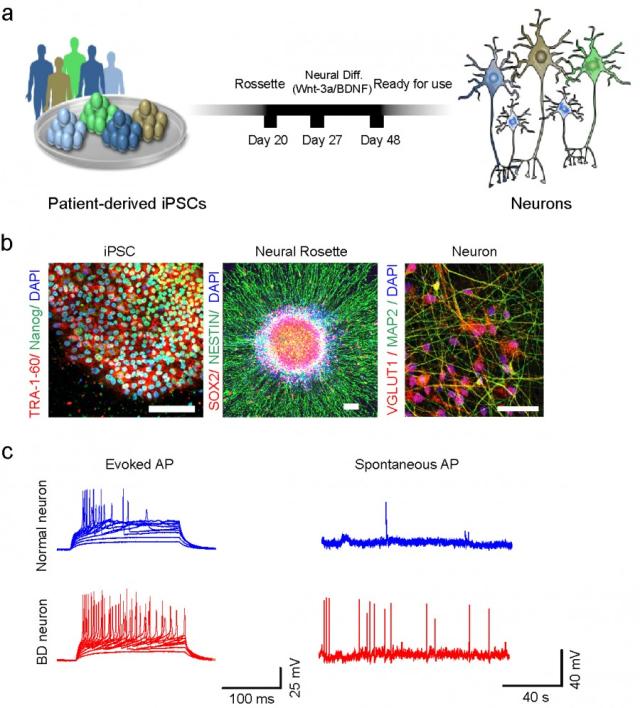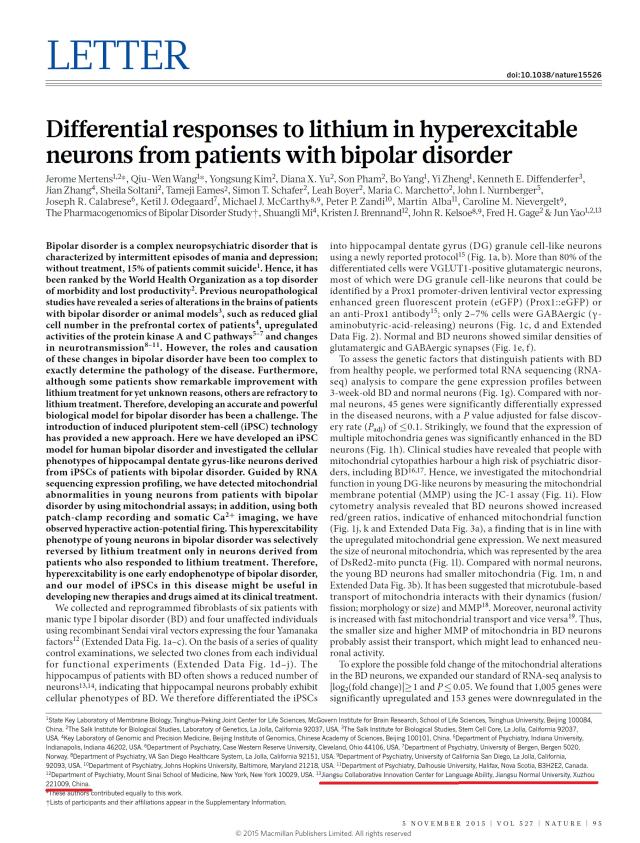2015年11月5日出版的Nature杂志(527,95–99)发表了语言能力协同创新中心高级研究员、清华大学生命中心姚骏研究员为联合通讯作者的文章:“躁狂抑郁症病人的超兴奋神经元对锂处理的选择性反应”(Differential responses to lithium in hyperexcitable neurons from patients with bipolar disorder)的研究论文,文章报道了在基于诱导多能干细胞技术的人类躁狂抑郁症的发病机制方面的最新研究进展。
双极性躁狂抑郁症(Bipolar Disorder, BD),的临床症状表现为躁狂与抑郁这两种极端相反的情绪间歇发生,认知能力明显受损,语言能力特别是句法能力下降显著。由于这类神经心理学疾病是多基因或多信号通路同时作用的结果,已发现的病理变化自身的发生机制以及它们相互之间的相互影响非常复杂,以致于领域内迄今仍无法确定BD的病理学特性和致病机制。
姚骏博士领导的团队使用细胞兴奋性和锂盐反应性作为两条指标,不但阐明了神经元超兴奋是躁狂症在细胞水平上的缺陷表型,而且发现了在BD神经元中PKA/PKC和线粒体相关基因与细胞兴奋性之间有相互关联的改变,意味着这些通路可能参与导致神经系统超兴奋。该研究在深入理解BD的发病机理、增强临床诊断和开发新疗法,揭示这类神经心理疾病的认知障碍特别是语言能力下降的机理,破解认知的脑机制等方面迈出了重要的一步。
原文链接:
Differential responses to lithium in hyperexcitable neurons from patients with bipolar disorder
原文摘要:
Bipolar disorder is a complex neuropsychiatric disorder that is characterized by intermittent episodes of mania and depression; without treatment, 15% of patients commit suicide. Hence, it has been ranked by the World Health Organization as a top disorder of morbidity and lost productivity. Previous neuropathological studies have revealed a series of alterations in the brains of patients with bipolar disorder or animal models, such as reduced glial cell number in the prefrontal cortex of patients, upregulated activities of the protein kinase A and C pathways and changes in neurotransmission. However, the roles and causation of these changes in bipolar disorder have been too complex to exactly determine the pathology of the disease. Furthermore, although some patients show remarkable improvement with lithium treatment for yet unknown reasons, others are refractory to lithium treatment. Therefore, developing an accurate and powerful biological model for bipolar disorder has been a challenge. The introduction of induced pluripotent stem-cell (iPSC) technology has provided a new approach. Here we have developed an iPSC model for human bipolar disorder and investigated the cellular phenotypes of hippocampal dentate gyrus-like neurons derived from iPSCs of patients with bipolar disorder. Guided by RNA sequencing expression profiling, we have detected mitochondrial abnormalities in young neurons from patients with bipolar disorder by using mitochondrial assays; in addition, using both patch-clamp recording and somatic Ca2+ imaging, we have observed hyperactive action-potential firing. This hyperexcitability phenotype of young neurons in bipolar disorder was selecively reversed by lithium treatment only in neurons derived from patients who also responded to lithium treatment. Therefore, hyperexcitability is one early endophenotype of bipolar disorder, and our model of iPSCs in this disease might be useful in developing new therapies and drugs aimed at its clinical treatment.
原文首页:


